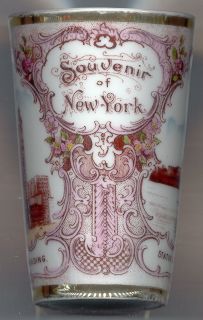
|
New York City is situated at an average elevation of 6 m in New York Bay at the mouths of
the Hudson and East Rivers. New York has apopulation of 8.1 million and thus is the largest city of the
United States. The city is divided into the five boroughs Manhattan (New York County), Brooklyn (Kings County),
Queens (Queens County), the Bronx (Bronx County) and Staten Island (Richmond County).
The earliest explorers to come to this area were Giovanni da Verrazano in 1524 and Henry Hudson in 1609.
After 1610 Dutch merchands began to trade with the local Indians. From 1614 until 1617 the Compagnie van
Nieuwnederlant had the monopole for the local trade, followed by the Dutch West-India Company after 1621.
The island of Manhattan was purchased from the local Indians in 1626 for the sum of 60 florin. The name
was taken from the Indian name, Manna-hatta. The new settlement was named Nieuw Amsterdam and
became the capital of the colony Nieuw Nederland. Under governor Petrus Stuyvesant a wall was built at the
southern end of the settlement, at the site of today's Wall Street. In 1664 the colony was ceded to England
and the settlement was renamed New York in honor of the Duke of York, the later King James II.
The Netherlands abandoned their claims in the Peace of Breda in 1667, and finally with the Treaty of
Westminster in 1674.
In the 18th century New York took an active part in the American struggle for independence. In 1776 it
temporarily was the headquarters of George Washington before it was taken by the British who left the town
only in 1783. Between 1788 and 1790 New York was the capital of the United States. It was also the capital
of the state of New York until the capital was moved to Albany in 1797.
During the 19th century New York grew rapidly. With the completion in 1825 of the Erie Canal, which connected
the Hudson River with the Grand Lakes, New York became the largest trading place on the American east coast.
Parts of the Bronx had been part of New York City already since 1874, and in 1898 the five boroughs of
Manhattan, Brooklyn, Richmond (Staten Island), Queens and the Bronx merged to become Greater New York.
|
|
The  Statue of Liberty on Liberty Island in New York Harbour was a present
of the French government to the United States it was originally meant to be completed for the 1876 centenary
of the American independence. However, it was not completed until ten years later. It was finally dedicated
on October 28, 1886. The statue was designed by Frédéric Auguste Bartholdi, the iron armature was
constructed by Gustave Eiffel, the famous engineer of the Eiffel Tower in Paris.
The height of the statue is 46.5 metres, the total height including the pedestal is 102 metres.
Although located on the New Jersey side of the boundary line between New Jersey and New York, Liberty
Island, until 1956 officially called Bedloe's Island, is not part of New Jersey but is a property of the
Federal government and is administered by the National Park Service. Since 1984 the Statue of Liberty is listed
as a World Heritage site by UNESCO (see also list of other UNESCO heritage sites). Statue of Liberty on Liberty Island in New York Harbour was a present
of the French government to the United States it was originally meant to be completed for the 1876 centenary
of the American independence. However, it was not completed until ten years later. It was finally dedicated
on October 28, 1886. The statue was designed by Frédéric Auguste Bartholdi, the iron armature was
constructed by Gustave Eiffel, the famous engineer of the Eiffel Tower in Paris.
The height of the statue is 46.5 metres, the total height including the pedestal is 102 metres.
Although located on the New Jersey side of the boundary line between New Jersey and New York, Liberty
Island, until 1956 officially called Bedloe's Island, is not part of New Jersey but is a property of the
Federal government and is administered by the National Park Service. Since 1984 the Statue of Liberty is listed
as a World Heritage site by UNESCO (see also list of other UNESCO heritage sites).
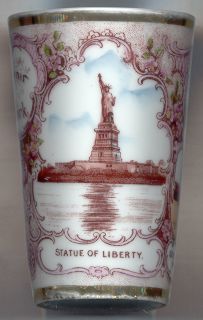
|
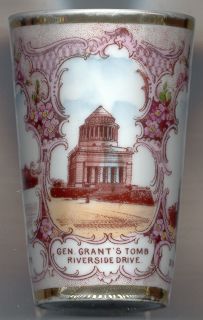
|
 General Grant's Tomb is located on Riverside Drive at West 122nd Street,
high above the river in the midst of a beutiful park. Made out of 8,000 tons of granite, with Massachusetts
marble for the floors and Italian marble for the railings and trimmings, it was once one of the most
popular tourist attractions of New York. Even before the death of Ulysses S. Grant, 18th President of the
United States, the Grant Monument Association had been formed to raise funds for constructing a monument
in his name. Ultimately, 90,000 people donated $600,000 to the project. At the time, this was the most money
that had ever been raised for a public monument. Large as this sum actually was, it was much too little
for the original ambitous design by architect John Duncan. The original vision was abandoned and the monument
itself was scaled back to half the size of the original plan. The monument, officially known as the General
Grant National Memorial, was dedicated on April 27, 1897. Both President Grant (d.1885) and his wife are
intombed here. The monument is the largest tomb in North America. General Grant's Tomb is located on Riverside Drive at West 122nd Street,
high above the river in the midst of a beutiful park. Made out of 8,000 tons of granite, with Massachusetts
marble for the floors and Italian marble for the railings and trimmings, it was once one of the most
popular tourist attractions of New York. Even before the death of Ulysses S. Grant, 18th President of the
United States, the Grant Monument Association had been formed to raise funds for constructing a monument
in his name. Ultimately, 90,000 people donated $600,000 to the project. At the time, this was the most money
that had ever been raised for a public monument. Large as this sum actually was, it was much too little
for the original ambitous design by architect John Duncan. The original vision was abandoned and the monument
itself was scaled back to half the size of the original plan. The monument, officially known as the General
Grant National Memorial, was dedicated on April 27, 1897. Both President Grant (d.1885) and his wife are
intombed here. The monument is the largest tomb in North America.
|
|
The  Singer Building at 149 Broadway and Liberty Street, was constructed in
1906–1908. At the time of its completion it was the world's tallest building (612 ft, 187 m),
surpassed, however, already 18 months later by the Metropolitan Life Insurance Company Tower (700 ft, 213 m, 47 floors).
Plans to enlarge the Singer Company headquarters at Broadway and Liberty Street in lower Manhattan began
in 1902 when the sewing machine company purchased properties to the north and west. An initial design by
architect Ernest Flagg was a thirty-five story tower, but the Singer company soon decided to nearly double
that height with a tower of almost 600 feet. Flagg was a supporter of height limitations and restrictive
zoning, and showed his solution to tall building crowding with the Singer's set-back design. The 12-story
base of the building filled an entire blockfront, while the tower above was very narrow.
Since the floorplate of the tower section measured only
65 ft (19.5 m) across, the Singer building was finally viewed as obsolete and unprofitable.
The building was demolished in 1966 to make way for the U.S. Steel Building, today known as One Liberty Plaza (743 ft, 226 m),
which was completed in 1973. Singer Building at 149 Broadway and Liberty Street, was constructed in
1906–1908. At the time of its completion it was the world's tallest building (612 ft, 187 m),
surpassed, however, already 18 months later by the Metropolitan Life Insurance Company Tower (700 ft, 213 m, 47 floors).
Plans to enlarge the Singer Company headquarters at Broadway and Liberty Street in lower Manhattan began
in 1902 when the sewing machine company purchased properties to the north and west. An initial design by
architect Ernest Flagg was a thirty-five story tower, but the Singer company soon decided to nearly double
that height with a tower of almost 600 feet. Flagg was a supporter of height limitations and restrictive
zoning, and showed his solution to tall building crowding with the Singer's set-back design. The 12-story
base of the building filled an entire blockfront, while the tower above was very narrow.
Since the floorplate of the tower section measured only
65 ft (19.5 m) across, the Singer building was finally viewed as obsolete and unprofitable.
The building was demolished in 1966 to make way for the U.S. Steel Building, today known as One Liberty Plaza (743 ft, 226 m),
which was completed in 1973.
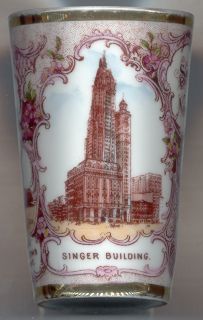
|
|
|
Brooklyn
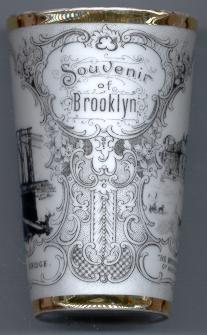
|
Brooklyn is situated at the western end of Long Island. It is coterminous with Kings County
and has a population of 2.5 million, maing it the most populous of the five boroughs of New York City.
Brooklyn was one of six settlements founded by the Dutch West India Company on the East River shore:
Gravesend in 1645, Breuckelen (Brooklyn) 1646, Niew Amersfoort (Flatlands) 1647,
Midwout (Flatbush) 1652, Nieuw Utrecht (New Utrecht) 1657 and Boswijck (Bushwick) 1661.
After the conquest of New Netherlands by the English the area became part of the colony of New York.
On August 27, 1776, the Battle of Long Island (also known as the Battle of Brooklyn) was the first major
engagement fought in the American Revolutionary War, leaving the British in control of New York Harbor.
The surrounding region was controlled by the British for the duration of the war and New York only changed
from a British colony to an American state with the Treaty of Paris in 1783.
The first center of urbanization sprung up in the Town of Brooklyn, directly
across from Lower Manhattan, which saw the incorporation of the Village of Brooklyn in 1816. Town and Village
were combined to form the first, kernel incarnation of the City of Brooklyn in 1834. In parallel development,
the Town of Bushwick, a little farther up the river, saw the incorporation of the Village of Williamsburgh in
1827, which separated as the Town of Williamsburgh in 1840, only to form the short-lived City of Williamsburgh
in 1851. But the East River shore was growing too fast for the three-year-old infant City of Williamsburgh,
which, along with its Town of Bushwick hinterland, was subsumed within a greater City of Brooklyn in 1854.
Toward the end of the 19th century, the City of Brooklyn experienced its final, explosive growth spurt. In
the space of a decade, it annexed the Town of New Lots in 1886 (New Lots had separated from Flatbush in 1852),
the Town of Flatbush, the Town of Gravesend, and the Town of New Utrecht in 1894, and the Town of Flatlands
in 1896. In 1898, Brooklyn residents voted by a slight majority to join with Manhattan, the Bronx, Queens and
Richmond (later Staten Island) as the five boroughs to form the modern City of Greater New York.
|
|
 The Brooklyn Museum, located at 200 Eastern Parkway, Brooklyn, is the second
largest art museum in the New York City, and one of the largest in the United States. Opened in 1897, the
Brooklyn Museum building is a steel frame structure designed by the famous architectural firm of McKim, Mead,
and White. One of the premier art institutions in the world, its permanent collection includes more than
one-and-a-half million objects, from ancient Egyptian masterpieces to contemporary art, and the art of many
other cultures. The Brooklyn Museum, located at 200 Eastern Parkway, Brooklyn, is the second
largest art museum in the New York City, and one of the largest in the United States. Opened in 1897, the
Brooklyn Museum building is a steel frame structure designed by the famous architectural firm of McKim, Mead,
and White. One of the premier art institutions in the world, its permanent collection includes more than
one-and-a-half million objects, from ancient Egyptian masterpieces to contemporary art, and the art of many
other cultures.
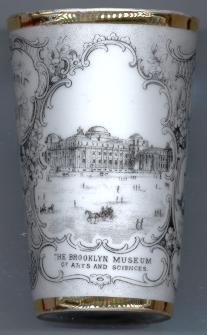
|
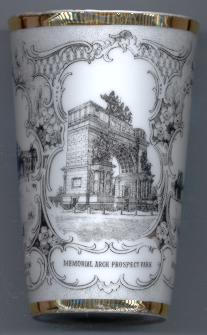
|
 Memorial Arch at the entrance of Prospect Park was designed by architect
John Duncan in 1889 and was intended to be a memorial to the Union's war heroes. The construction was
completed three years later, and President Grover Cleveland presided over its unveiling ceremony on
October 21, 1892. In 1896, sculptor Frederick MacMonnies was chosen to adorn the Arch with sculptures
depicting heroic Civil War battle scenes attended by Greco-Roman mythological figures. In 1926, the Plaza
received its current name, Grand Army Plaza, to honor the 60th anniversary of the Union victory in the
Civil War. Memorial Arch at the entrance of Prospect Park was designed by architect
John Duncan in 1889 and was intended to be a memorial to the Union's war heroes. The construction was
completed three years later, and President Grover Cleveland presided over its unveiling ceremony on
October 21, 1892. In 1896, sculptor Frederick MacMonnies was chosen to adorn the Arch with sculptures
depicting heroic Civil War battle scenes attended by Greco-Roman mythological figures. In 1926, the Plaza
received its current name, Grand Army Plaza, to honor the 60th anniversary of the Union victory in the
Civil War.
|
|
The  Brooklyn Bridge, originally known as the New York and Brooklyn Bridge,
stretches 6,516 feet (1,834 m) over the East River from Brooklyn to Manhattan. It is one of the
oldest suspension bridges in the Unted States and at the time of its completion was the world's largest
suspension bridge, and the first steel-wire suspension bridge. Construction began in 1869. The Brooklyn
Bridge was completed fourteen years later and was opened for use on May 24, 1883. The bridge was designed by
the architectural firm of John Augustus Roebling of Trenton, New Jersey. The bridge's main span over the
East River is 1,595 feet (486 m). The bridge was placed on the National Register of Historic Places in
1977 and in 1983 the bridge was designated a National Historic Engineering Landmark. Brooklyn Bridge, originally known as the New York and Brooklyn Bridge,
stretches 6,516 feet (1,834 m) over the East River from Brooklyn to Manhattan. It is one of the
oldest suspension bridges in the Unted States and at the time of its completion was the world's largest
suspension bridge, and the first steel-wire suspension bridge. Construction began in 1869. The Brooklyn
Bridge was completed fourteen years later and was opened for use on May 24, 1883. The bridge was designed by
the architectural firm of John Augustus Roebling of Trenton, New Jersey. The bridge's main span over the
East River is 1,595 feet (486 m). The bridge was placed on the National Register of Historic Places in
1977 and in 1983 the bridge was designated a National Historic Engineering Landmark.
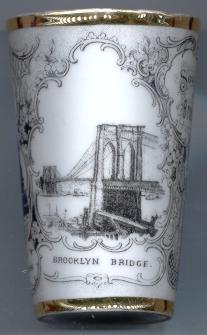
| | | | | | | | | |










![[scale]](lineal.jpg)